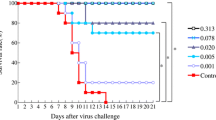Summary
Experiments in M. rhesus showed persistence to be a typical property of West Nile virus. This property was exhibited by strains belonging to different antigenic types, and varying in virulence and in the isolation area (U.S.S.R., Uganda, India). The duration of persistence was at least 5 1/2 months in asymptomatic infection and in convalescence after encephalitis or a febrile disease. The virus isolated within the first 2 weeks after inoculation of monkeys has the standard properties. The virus persisting for 2 months retains its cytopathic and antigenic activity, however, is non-pathogenic for white mice. After 5 1/2 months of persistence the virus has no neurovirulence or cytopathic properties but is capable of infecting the susceptible cells and induces in them the synthesis of virus-specific antigen detectable by immunofluorescence. The persisting virus has been isolated by cocultivation of trypsinized monkey organ cells and cells of the indicator culture. This virus was located mostly in the cerebellum, cerebral subcortical ganglia, lymph nodes, and kidneys. The monkeys experiencing encephalitis, febrile, or asymptomatic infection showed in morphological examinations a subacute inflammatory-degenerative process in the central nervous system. The results suggest that West Nile virus, one of the most widely spread arboviruses in Africa, Asia, and Europe, may be implicated in the etiology of subacute diseases of the CNS.
Similar content being viewed by others
References
Andzhaparidze, O. G., Bogomolova, N. N.: Modeling and Study of Chronic Forms of Virus Infections in Cell Cultures (in Russian), 150. Moscow: Medizina Publishers 1974.
Asher, D. M.: Persistent tick-borne encephalitis infection in man and monkeys: relation to chronic neurological disease. Arctic and tropical arboviruses. (Proc. 2nd Intern. Symp. on Arctic arboviruses. Mont Gabriel, Canada), 179–195. New York: Acad. Press 1979.
Butenko, A. M., Chumakov, M. P., Stolbov, D. N.: Serological and virological studies in a West Nile fever focus in Astrakhan region (in Russian). In:Chumakov, M. P. (ed.), Materials of the XIIIth scientific conference of the U.S.S.R. AMS Institute of Poliomyelitis and Viral Encephalitides, 208–211. Moscow 1967.
Chumakov, M. P., Vorobieva, N. I., Belyaeva, A. P.: Investigation of ultrastructural encephalitides. III. Kozhevnikov's epylepsy and tick-borne encephalitis (in Russian). Neuropath. Psychiat.13, 65–68 (1944).
Goldblum, N.: West Nile fever: the clinical features of the disease and the isolation of WN virus from the blood of nine human cases. Amer. J. Hyg.59, 89–103 (1954).
Iliyenko, V. I., Komandenko, N. I., Platonov, V. G., Prozorova, I. N., Panov, A. G.: Investigation of the pathogenesis of chronic forms of tick-borne encephalitis. Acta virologica18, 341–346 (1974).
Jarman, R. V., Morgan, P. N., Duffy, C. E.: Persistence of West Nile virus in L-920 mouse fibroblasts. Proc. Soc. exp. Biol.129, 633–637 (1968).
Katz, E., Goldblum, N.: Establishment, steady state, and cure of a chronic infection of LLC cells with West Nile virus. Arch. ges. Virusforsch.25, 69–82 (1968).
Kraminskaya, N. N., Zhivolyapina, R. R., Meyerova, R. A.: Experience of virological study of hyperkinetic forms of tick-borne encephalitis with progredient course (in Russian). In:Chumakov, M. P. (ed.), Important Problems of Virology and Prevention of Viral Infections, Abstracts of papers of the XVIIth scientific conference of the U.S.S.R. AMS Institute of Poliomyelitis and Viral Encephalitides, 224–225. Moscow: 1972.
Melnick, J. L., Paul, J. R., Riordan, J. T., Barnett, V. N., Goldblum, N., Labin, B.: Isolation from human sera in Egypt of a virus apparently identical to WN virus. Proc. Soc. exp. Biol. Med.77, 661–665 (1951).
Panthier, R., Hannoun, C., Peytent, D., Mouchet, J.: Epidemiology of the West Nile virus: study of a form in Camarque, the human diseases. Ann. Inst. Pasteur115, 435–445 (1968).
Pogodina, V. V., Savinov, A. P.: Variation in the pathogenicity of viruses of the tick-borne encephalitis complex for different animal species. 1. Experimental infection of mice and hamsters. Acta virologica8, 424–434 (1964).
Pogodina, V. V., Kiseleva, L. L., Levina, L. S.: Studies in specific prophylaxis of Japanese encephalitis. II. Prospects of immunization with attenuated heterologous and homologous strains. (Proc. Symp. on field trials of vaccines, Zagreb), 171–178 (1973).
Pogodina, V. V., Koreshkova, G. V.: Interspecies interactions of arboviruses. III. Participation of the genomes of two flaviviruses, West Nile and Japanese encephalitis, in formation of a virus clone with dual antigenic determinants. Acta virologica21, 8–14 (1977).
Pogodina, V. V., Frolova, M. P., Malenko, G. V., Fokina, G. I., Levina, L. S., Mamonenko, L. L., Koreshkova, G. V., Ralph, N. M.: Persistence of tick-borne encephalitis virus in monkeys. 1. Features of experimental infection. Acta virologica25, 337–343 (1981).
Raićani, J., Ćiampor, F.: Experimental pathogenesis of non-lethal herpesvirus infection and the establishment of latency. Acta virologica22, 278–286 (1978).
Semenov, B. F., Chunikhin, S. P., Karmysheva, V. Ya., and others: Study of chronic forms of arbovirus infections in birds. 1. Experiments with West Nile, Sindbis, Bhanja, and Sycilian phlebotomus fever viruses (in Russian). Vestnik AMN S.S.S.R.2, 79–83 (1973).
Shope, Th. C., Klein-Robbenhaar, T., Miller, G.: Fatal encephalitis due to herpesvirus hominis: use of infant brain cells for isolation of virus. J. Inf. Dis.125, 542–544 (1972).
Southam, C. N., Nojes, W. F., Mellors, R.: Virus in human cancer cellsin vivo. Virology5, 395–400 (1958).
WHO — The application of advances in neuroscience for the control of neurological disorders. WHO Techn. Rep. Series No. 629, Geneva (1978).
Work, T. H.: On the Japanese B — West Nile virus complex or an arbovirus problem of six continents. Amer. J. Trop. Med. & Hyg.20, 169–186 (1971).
Author information
Authors and Affiliations
Additional information
With 1 Figure
Rights and permissions
About this article
Cite this article
Pogodina, V.V., Frolova, M.P., Malenko, G.V. et al. Study on West Nile virus persistence in monkeys. Archives of Virology 75, 71–86 (1983). https://doi.org/10.1007/BF01314128
Received:
Accepted:
Issue Date:
DOI: https://doi.org/10.1007/BF01314128




